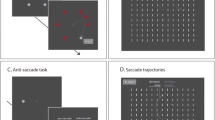Abstract
When inspecting an image for the first time, how does the viewer decide where to look next? The saliency map hypothesis proposes that viewers initially analyse the image for variations in low-level visual features including intensity, colour, and edge orientation, and that their eyes are guided towards the most salient region. The saliency of objects in scenes may provide an explanation of why some experiments find that incongruent objects attract attention whilst other studies do not find this effect. Experiments that have monitored eye movements during scene inspection have found some support for the saliency map hypothesis, particularly when pictures are inspected in anticipation of a memory test. Under some circumstances the hypothesis fails to account for inspection patterns. When scenes are inspected to check the presence or absence of a named object, or when two images are compared to determine whether they are identical, or when the viewer has specialised domain knowledge of the scene depicted, then saliency has little influence. This paper evaluates the saliency map hypothesis of scene perception using evidence of eye movements made when images are first inspected, and concludes that visual saliency can be used by viewers, but that its use is both task-dependent and knowledge-dependent.






Similar content being viewed by others
References
Biederman I, Mezzanotte RJ, Rabinowitz JC. Scene perception: detecting and judging objects undergoing relational violations. Cognit Psychol. 1982;14:143–77.
Murphy GL, Wisniewski EJ. Categorizing objects in isolation and in scenes: what a superordinate is good for. J Exp Psychol Learn Mem Cogn. 1989;15:572–86.
Davenport JL, Potter MC. Scene consistency in object and background perception. Psychol Sci. 2004;15:559–64.
Mackworth NH, Morandi AJ. The gaze selects informative details within pictures. Percept Psychophys. 1967;2:547–52.
Loftus GR, Mackworth NH. Cognitive determinants of fixation location during picture viewing. J Exp Psychol Hum Percept Perform. 1978;4:565–72.
Underwood G, Humphreys L, Cross E. Congruency, saliency and gist in the inspection of objects in natural scenes. In: van Gompel RPG, Fischer MH, Murray WS, Hill RL, editors. Eye movements: a window on mind and brain. Oxford: Elsevier; 2007. p. 561–77.
De Graef P, Christiaens D, d’Ydewalle G. Perceptual effects of scene context on object identification. Psychol Res. 1990;52:317–29.
Henderson JM, Weeks PA, Hollingworth A. The effects of semantic consistency on eye movements during scene viewing. J Exp Psychol Hum Percept Perform. 1999;25:210–28.
Gareze L, Findlay JM. In: van Gompel RPG, Fischer MH, Murray WS, Hill RL, editors. Eye movements: a window on mind and brain. Oxford: Elsevier; 2007. p. 617–37.
Findlay JM, Walker R. A model of saccade generation base on parallel processing and competitive inhibition. Behav Brain Sci. 1999;4:661–721.
Torralba A, Castelhano MS, Oliva A, Henderson JM. Contextual guidance of eye movements and attention in real-world scenes: the role of global features on object search. Psychol Rev. 2006;113:766–86.
Navalpakkam V, Itti L. Modeling the influence of task on attention. Vision Res. 2005;45:205–31.
Itti L, Koch C. A saliency-based search mechanism for overt and covert shifts of visual attention. Vision Res. 2000;40:1489–506.
Koch C, Ullman S. Shifts in selective visual attention: towards the underlying neural circuitry. Hum Neurobiol. 1985;4:219–27.
Itti L. Quantitative modelling of perceptual salience at human eye position. Vis Cogn. 2006;14:959–84.
Elazary L, Itti L. Interesting objects are visually salient. J Vis. 2008;8(3):3.1–15.
Russell BC, Torralba A, Murphy KP, Freeman WT. LabelMe: a database and a web-based tool for image annotation. Int J Comput Vis. 2008;77:157–73.
Treisman AM, Gelade G. A feature-integration theory of attention. Cognit Psychol. 1980;12:97–136.
Parkhurst D, Law K, Niebur E. Modelling the role of salience in the allocation of overt visual attention. Vision Res. 2002;42:107–23.
Underwood G, Foulsham T, van Loon E, Humphreys L, Bloyce J. Eye movements during scene inspection: a test of the saliency map hypothesis. Eur J Cogn Psychol. 2006;18:321–42.
Underwood G, Foulsham T. Visual saliency and semantic incongruency influence eye movements when inspecting pictures. Q J Exp Psychol. 2006;59:1931–49.
Underwood G, Jebbett L, Roberts K. Inspecting pictures for information to verify a sentence: eye movements in general encoding and in focused search. Q J Exp Psychol. 2004;57A:165–82.
Underwood G, Templeman E, Lamming L, Foulsham T. Is attention necessary for object identification? Evidence from eye movements during the inspection of real-world scenes. Conscious Cogn. 2008;17:159–70.
Stirk JA, Underwood G. Low-level visual saliency does not predict change detection in natural scenes. J Vis. 2007;7(10):3.1–10.
Underwood J, Templeman E, Underwood G. Conspicuity and congruity in change detection. Lect Notes Comput Sci. 2008.
Galpin AJ, Underwood G. Eye movements during search and detection in comparative visual search. Percept Psychophys. 2005;67:1313–31.
Becker MW, Pashler H, Lubin J. Object-intrinsic oddities draw early saccades. J Exp Psychol Hum Percept Perform. 2007;33:20–30.
Tatler BW, Baddeley RJ, Gilchrist ID. Visual correlates of fixation selection: effects of scale and time. Vision Res. 2005;45:643–59.
Tatler BW. The central fixation bias in scene viewing: selecting an optimal viewing position independently of motor biases and image feature distributions. J Vis. 2007;7(14):4.1–17.
Foulsham T, Underwood G. What can saliency models predict about eye-movements? Spatial and sequential aspects of fixations during encoding and recognition. J Vis. 2008;8(2):6.1–17.
Humphrey K, Underwood G. Domain knowledge moderates the influence of visual saliency in scene recognition. Br J Psychol. 2009;100 (in press).
Acknowledgement
The U.K. Engineering and Physical Sciences Research Council (EPSRC) supported this work with project award EP/E006329/1. I am indebted to Laurent Itti for making available his program for determining saliency maps.
Author information
Authors and Affiliations
Corresponding author
Rights and permissions
About this article
Cite this article
Underwood, G. Cognitive Processes in Eye Guidance: Algorithms for Attention in Image Processing. Cogn Comput 1, 64–76 (2009). https://doi.org/10.1007/s12559-008-9002-7
Published:
Issue Date:
DOI: https://doi.org/10.1007/s12559-008-9002-7




